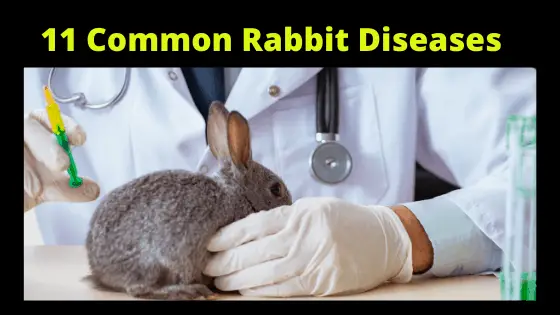As a general rule good husbandry practices will help you avoid common illness due to sanitation. The most frequent illnesses according to their origin like bacterial, parasitic, viral, fungal, hereditary, and other health issues . transmitted by mosquitos, fleas, or through direct contact with contaminated or infected rabbits. 1) MYXOMATOSIS 2) RABBIT CALIVIRUS 3) SNUFFLES 4) COCCIDIOSIS 5) UTERINE TUMOR 6) HEAT STROKE 7) EAR MITES 8) SORE HOCKS
Common Illnesses in Rabbits.
Rabbits are prone to several diseases that different origin-like any other living thing. We are going to organize and Show how to Prevent, the most frequent illnesses according to their origin like bacterial, parasitic, viral, fungal, hereditary, and other health issues.
Most of the rabbit’s diseases are specific to them only, which means that the conditions don’t transmit between different animal species. Therefore, if any other animal is there with the rabbits, then there is no need to worry about the contagions of life-threatening diseases.
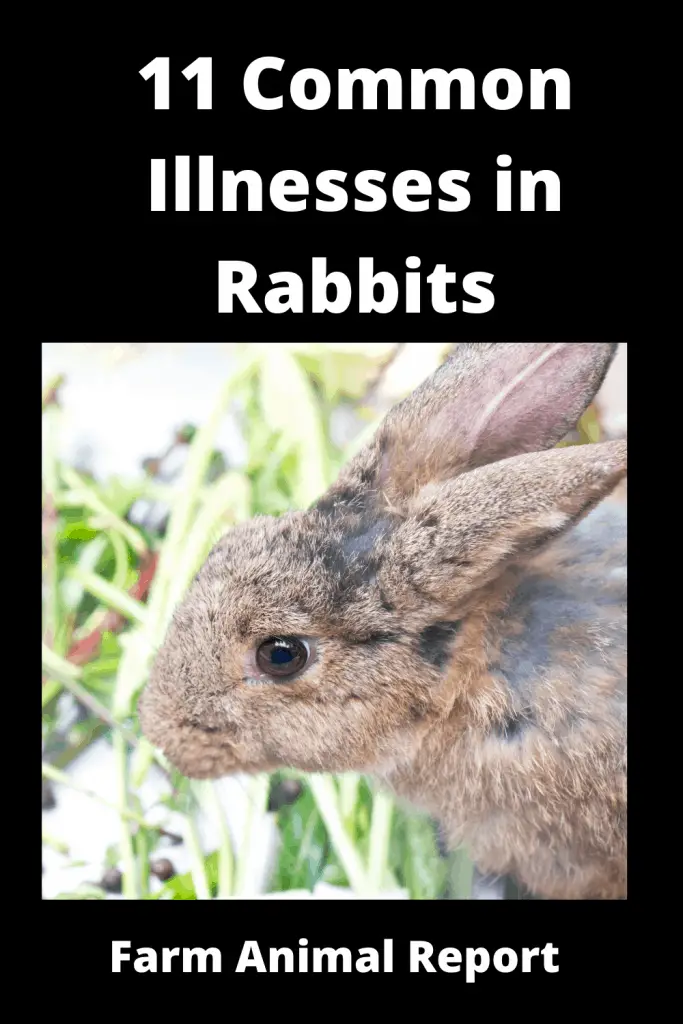
Raising rabbits is always essential as some certain illnesses and diseases commonly appear in rabbits. It is vital to understand these diseases and to recognize them in a timely fashion, so they don’t get out of control.
Therefore, below are certain diseases that occur in rabbits along with the treatment and their prevention. The common illnesses among rabbits are:
Common Illnesses in Rabbits / COMMON VIRAL DISEASES: –
MYXOMATOSIS: –
It is another viral disease of rabbits that is transmitted by mosquitos, fleas, or through direct contact with contaminated or infected rabbits. This disease characterized by swelling of eyes, discharge from nose, eyes, and genital region.
You can also Read our Guide –18 Ways to Make Money by Rabbit Farming—Extensive Guidelines for Rabbit Farmers
CLINICAL SIGNS: –
It takes 5-6 days for the symbols to appear. The symptoms of the disease include swelling of the eyelids, loss of appetite, inflamed lips, ears, breast, genital, inflammation of nose with discharge, and appearance of pustules around the mucus membrane.
TREATMENT: –
This disease is a fatal disease and no specific treatment as a viral disease.
PREVENTION: –
The prevention of this disease is by having the rabbits vaccinated before spring and summer season.
Summer has more chances for the condition to appear.Other prevention from this disease is by controlling the mosquitoes and fleas. This control is possible by having mosquito-proof hutch for rabbits. It is also better to bring rabbits inside the cage before dawn and evening as the level of mosquitoes is higher at the time. The control of flea can also help to reduce the chances of this disease. It is always better to isolate a new rabbit for a minimum of 2 weeks, before introducing that rabbits.
What is Blue Breast Disease in Rabbits?
Blue breast disease is a condition that affects rabbits and can cause their breasts to become blue in color. While the disease is not typically fatal, it can be quite serious and should be treated by a veterinarian as soon as possible. In this blog post, we will discuss the symptoms of blue breast disease, how it is diagnosed, and how it is treated.
##What causes Blue Breast Disease in Rabbits?
The causes of blue breast disease are not well understood. It is likely that the cause of this condition varies from case to case and may depend on the rabbit’s genetics, diet, and environment.
There have been three major theories about what causes Blue Breast Disease in Rabbits:
- A lack of vitamins (especially vitamin D) or minerals in the diet
- A build up of toxins in the body, often from eating poisonous plants
- An infection with a type of bacteria called Bordetella bronchiseptica
None of these theories have been proven to be the sole cause of blue breast disease. However, it is likely that one or more of them play a role in causing this condition.
The best way to prevent blue breast disease is by making sure your rabbit has a healthy diet and exercise routine. Rabbits need plenty of fresh hay, vegetables, water, and fruit every day so they can stay fit and happy! It’s also important not to let them get too hot or cold because this can affect their health.
If you think your rabbit may have blue breast disease, it is important to take them to the veterinarian as soon as possible for diagnosis and treatment.
RABBIT CALIVIRUS (HAEMORRHAGIC VIRAL DISEASE)
This viral disease spread through blood-sucking vectors like flies, mosquitoes, and via direct and indirect contact with the infected rabbit.
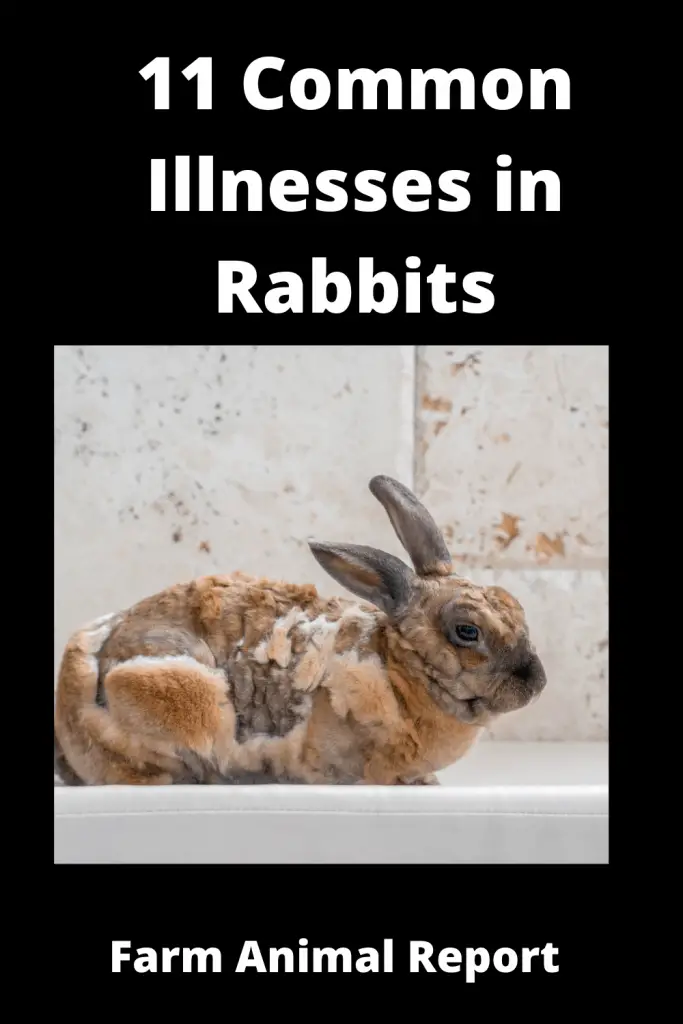
CLINICAL SIGNS: –
The clinical signs and symptoms of this viral disease comprise a lack of appetite, restlessness, fever, and tiredness. This disease also affects the liver of the rabbits by causing sudden liver damage along, which result in blood-clotting deformities. With the blood supply obstruction in the main organs, this disease is a fatal illness.
TREATMENT
No particular remedy is there for this viral disease. With an earlier diagnosis, there are more chances for the rabbit to survive.
PREVENTION: –
Control of the mosquitoes and flies will help to reduce the risk of this ailment. Avoid any direct or indirect contact with the infected rabbit, and the infected rabbit must be in isolation.
Vaccination is another method to prevent this viral ailment. It should administer every six months from the adult rabbits. If the rabbits are not vaccinated against this disease previously, then they need two vaccination shots with thirty days intervals.
The young rabbits need to get the vaccination from one month of age with a gap of 30 days until the rabbit reaches three months of age. After that, repeat the booster vaccination dose every six months.
What is Normal Rabbit Poop
COMMON BACTERIAL DISEASE: –
SNUFFLES: –
It is an infectious disease of rabbits caused by Pasteurella bacterium.
CLINICAL SIGNS:-
Snuffles characterized by sneezing and discharge from nose or eyes. The bacterium does affect other body parts and can cause ear infection resulting in head tilt, abscesses, uterine infection. This bacterial disease can cause sudden death due to septicemia, which is rare but does happen.
TREATMENT: –
Pasteurella is an easy bacterium to treat, but it is impossible to cure. Several rabbits may develop chronic infection and often have discharge from eyes with the snuffy nose. The vet will recommend some antibiotics along with nasal and eye drops.
PREVENTION: –
The new rabbit remains to isolate for one month before introducing with the existing rabbits. The owner should alter the litter regularly to avoid ammonia accumulation through urine, and this ammonia can use irritation to eyes and nose.
The other way to prevent this disease is by providing rabbits with a healthy diet and by keeping the rabbit’s hutches clean. Snuffles is a bacterial disease; therefore, it is crucial to boost the immunity of the rabbit to fight with such bacteria.
COMMON PARASITIC DISEASE: –
COCCIDIOSIS
It is one of the most deadly diseases of rabbits. Coccidia is the micro-organisms that attach the gastrointestinal tract of the rabbit. These micro-organisms typically live in the digestive system, but the higher level of stress triggers this disease.
CAUSES AND CLINICAL SIGNS: –
This disease is fatal, and it occurs in baby rabbits around the age of 4-6 weeks. The most frequent signs are the loss of hair along with the digestive ailments. The coccidia can lead to continuous diarrhea and the production of excessive gas.
Later on, the infected rabbit goes off-feed, refuse to drink water, upset stomach, and eventually dies.
PREVENTION: –
It is better to raise rabbits in hutches and avoid colony setting. The colony setting is difficult to clean and enhances the risk of coccidia. The disease usually spread through feces; therefore cleaning is a better way to keep this disease away.
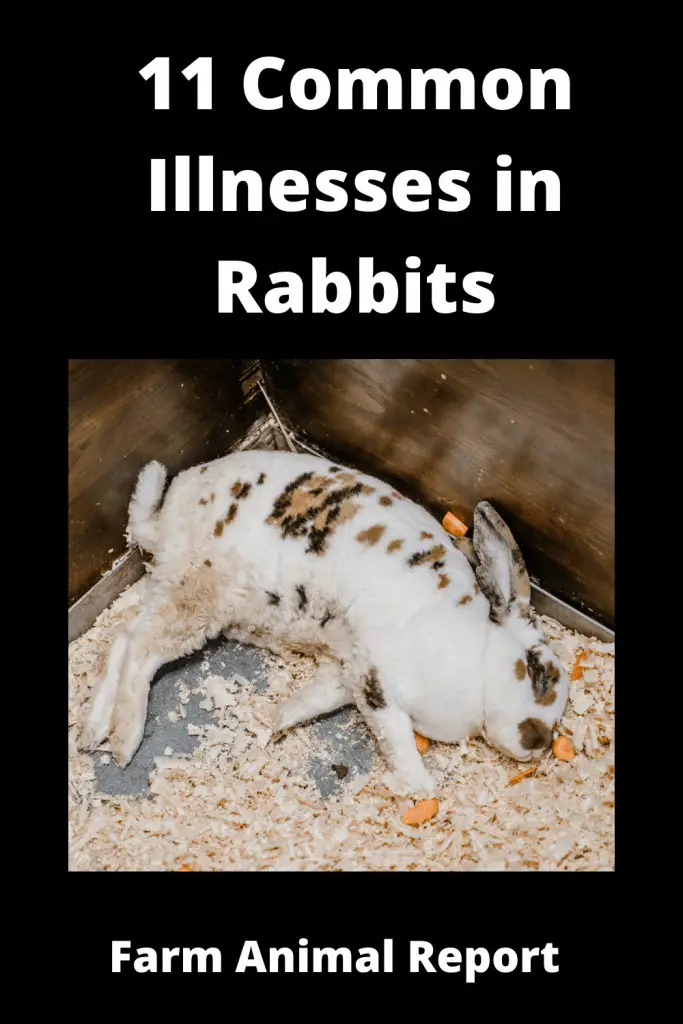
MISCELLANEOUS DISEASES: –
UTERINE TUMOR: –
The cancer of the tumor often develops in female rabbits. There is always suspect of tumor in any de-sexed female rabbits at any time. The incidence of uterine cancer is 50-80% by the age of 5 years. Therefore, it is recommended to neuter a female rabbit early in life.
CLINICAL SIGNS: –
The common signs of uterine cancer comprise bloody vaginal discharge, aggressive behaviour, lethargy, and cyst appear on the mammary gland.
TREATMENT: –
It is better to neuter/ de-sex before the spread of tumour throughout the body.
PREVENTION: –
De-sexing of female rabbits at the age of 4-6 months of age is the prevention of this disease.
Over-grown incisors: –
The incisors or the front teeth of rabbit grow continuously throughout their life. The regular chewing on the woodblocks or the food keeps them a reasonable length. However, it happens sometimes that the incisors have excessive growth due to a hereditary problem. This overgrowth of the teeth displaces mandible or maxilla backward with the resultant spacing issue.
The excessive growth of the teeth will make it difficult for the rabbit to eat correctly, and therefore they will not groom.
CLINICAL SIGNS: –
The common signs of excessive growth of the teeth include off feed, drooling, the coat becomes ragged.
TREATMENT: –
The vet will treat the overgrowth by filing the incisors under anaesthesia. The vet will burr the teeth flat. Clipping of teeth may cause fracture of the teeth and may result in infection.
PREVENTION:-
The 80-90% diet of the rabbits should be the fibre in the form of grass hay. The remaining diet should consist of green leaves with pellets and other treats being nominal to non-existent.
This prevention of this illness is possible by a regular visit to the vet and have appropriate trimming daily.
HEAT STROKE: –
Rabbits are more accustom to cold compared to heat as they came from a lower temperature. Some breeds of rabbits can tolerate -10O. However, the temperature touching 30O is too high for rabbits.
It is one of most common issue rabbits usually face when it comes to keeping rabbit. In the hot season, rabbits need shade with a surplus quantity of water as heat can get them quickly. Therefore, if they get exposed to heat without shelter and water to regulate their body temperature, then they may suffer a heat stroke and can die within a short time by cardiac arrest. High temperature causes dehydration and death in short duration.
CLINICAL SIGNS: –
The symptoms include continuous panting stretching of their legs and leaving their belly in contact with the ground to cool them down.
TREATMENT: –
Try to lower the rabbit’s body temperature by gently spray lukewarm water on them. Take rabbits to vet as soon as possible who may treat the rabbit with I/V fluids.
PREVENTION: –
The best way to prevent heatstroke is by providing indirect fan blow to the rabbits so that the colder air circulates them. Avoid a direct air blow on them as it may lead to other problem for the rabbits.
Try to provide frozen water bottles so that rabbits can lay next to the cold containers and absorb some cold from them.
EAR MITES: –
These mites are tiny bugs that can stay in the ears of rabbits. With the presence of parasites in the ear, it gives the crusty, brown, itchy appearance to the ear. Therefore, if the rabbit is scratching the ear, there are chances that mites are there in the ear.
CLINICAL SIGNS:
The rabbit will keep scratching the ears.
TREATMENT: –
By providing even a balanced diet to the rabbits, there are chances of ear mites to appear as they live in the hay. The best remedy for ear mites is by filling the drop with vegetable oil and pouring a few drops in the ear infected by parasites twice in a day for seven days. This vegetable oil will overwhelm the ear mites and get free from the crusty skin in the ear. Please don’t try to pick the ear mites as it is painful, and it will enhance the possibility of infection.
PREVENTION: –
The best procedure to avoid ear mites is by placing hay in a hay feeder and prohibits the rabbit from laying in it. Try to add a droplet of oil in each rabbit’s ear once a week as a precautionary measure,
HAIRBALLS (TRICHOBEZOARS)
As it is the rabbit’s habit to self-groom them, thus hairballs can found in the rabbit’s stomach. Rabbits cannot throw up the hairballs; therefore, the hair must be pass through the gut. The accumulation of hair in the abdomen leads to obstruction and severe problems. Hairballs issue is so usual that it must recognize as a problem in any rabbit that is off feed and lethargic.
TREATMENT: –
After diagnosing hairballs through X-rays of the stomach, the vet will recommend surgery as hairballs usually cause blockage of the gut. The vet will also give some medication to prompt the gut for proper working. The vet may inject fluid therapy.
PREVENTION: –
To prevent hairballs, a diet containing high fibre will help to prevent hairballs. Regular brushing is also vital in removing the excessive dead hair
SORE HOCKS
The development of sore on the hocks of rabbits known as sore hocks. Sore hocks are painful for the rabbit, but sore hocks are easy to prevent. Sore hocks do occur when the rabbit is living in non-ideal environments or in the place where their feet don’t get rest. This restlessness makes the feet abrasive and sore on the bottom. These two points should be in mind, especially in wire cages.
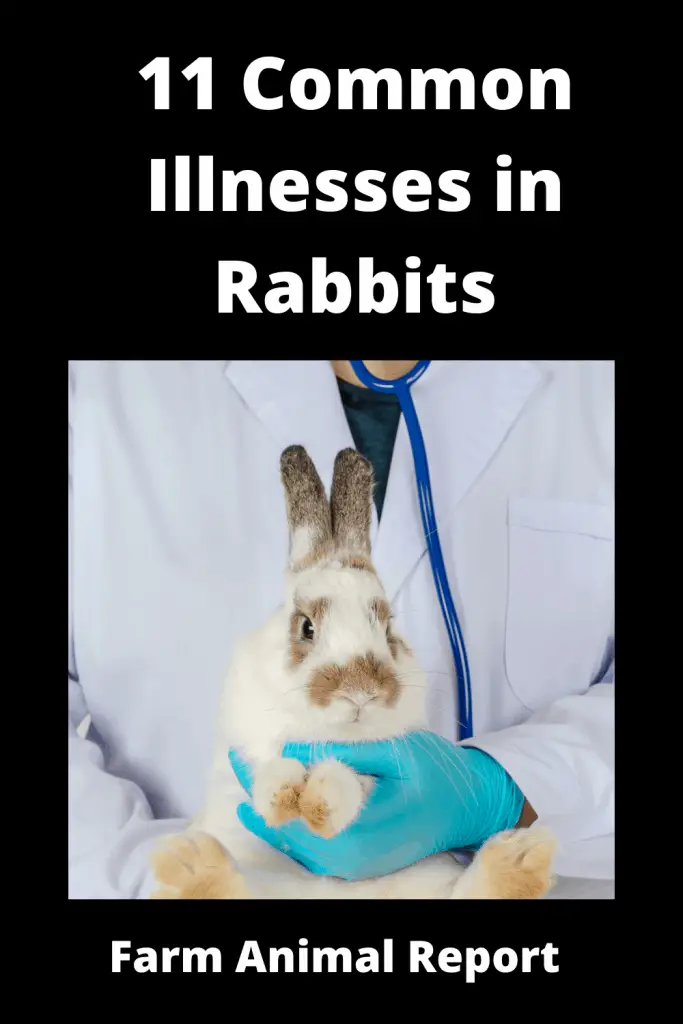
CLINICAL SIGNS: –
The hocks of rabbits become inflamed, red and ulcerated.
TREATMENT: –
Treatment of sore hocks is a bit difficult, especially if the condition is in the advanced stage. The cleaning of the wound with anti-bacterial medicines. The will recommend soft bedding for the rabbit to permit the sores to heal.
PREVENTION: –
Try to prevent the conditions that enhance the occurrence of sore hocks. Provide soft bedding to the rabbit. Appropriated cleaning of the hutch regularly is essential.
Head Tilt
It is another common disease in rabbits, and it is very usual for the owners to here about this disease. In head tilt, the rabbit will flop his head to one side. It is also known as wry neck. In this ailments, the eyes also go side to side in a quick manner too.
There are several reasons for head tilt, and the treatment depends on the cause of the disease. The potential causes of head tilt in rabbits are
- Trauma: – A blow to the head may cause the damage of brain which equates to the rabbit permanent tilting his head to one side or the other.
- Cancer: – Presence of tumour in the head, neck, or spine of the rabbit can cause head tilting.
- Stroke: – A stroke can result in sudden head tilt in rabbits.
- Ear Infection: – A middle or inner ear infection can cause signs of vertigo that associates to him sloping his head over.
As mentioned above, there is no exact diagnosis of head tilt without the help of a vet. The cause will help to treat the object correctly.
SUMMARY OF THE PREVENTION: –
The owner of the rabbit must follow the following points to avoid major diseases.
- Follow the complete vaccination schedule
- Maintain proper hygienic condition
- Provide a healthy and balanced diet
- Provide the requirement to do exercise along with proper rest.
- Avoid any stress to rabbits.
- Regular check-up of body and coat
- Keen observation of the rabbit behavior
- Isolation of new rabbit before introducing to the flock
- Cleaning of the cages regularly
- Disinfection of feed and water utensils
- Remove the dead rabbit as soon as possible
- Keep an optimal and comfortable temperature
- Don’t put direct airflow on rabbits as it can make them sick
- It is always better to keep individual spaces while transportation of rabbits


